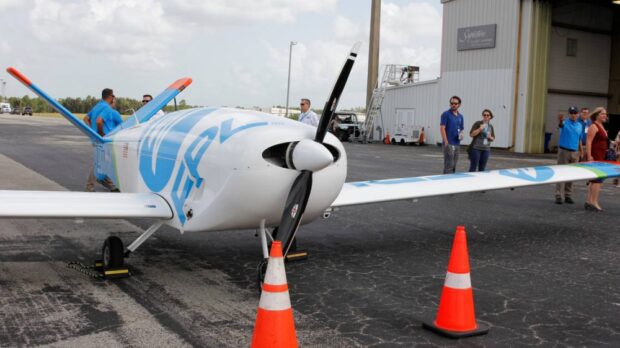Florida’s primary energy provider is ready to launch a powerful new technology, just ahead of the busiest weeks of the Atlantic hurricane season: a new fixed-wing drone designed fly into tropical storm force winds and speed the restoration of electricity after severe weather.
On 10 Aug, at the Florida Power & Light (FPL) home field in Palm Beach, FL, FPL and NASC successfully conducted a “First Flight” unveiling and Ribbon Cutting ceremony for their Teros UAS christened “FPLAir One”.
The event went smoothly and the aircraft and NASC/FPL crew performed perfectly. FPL was extremely pleased and the several hundred invited guests and dignitaries were justifiably impressed. This flight was almost two years in the making and was a vital step in the future success of the Navmar Applied Sciences.
FPLAir One resembles a small plane and is remotely operated, enabling the utility to capture and deliver images and video of damaged electrical equipment in real time to its command center. It can fly up to 1000 miles (1600 kilometers) at a time — enough to cover the length of Florida twice in the immediate wake of the most damaging storms.
It’s a vast improvement on bucket trucks and hand-held drones when it comes to learning what a storm did at the top of a power pole.
“Rather than going out and try to figure out what’s going on, we’re able to save hours and days on getting the lights on,”
Chairman and CEO Eric Silagy told The Associated Press.
The drone can even be pre-deployed when a major storm hits, skirting around to its wake and following its path across the utility’s power grid. That data can then point ground crews exactly where they need to go, he said.
While satellites need sunny days to document damage, drones can fly under the cloud cover. And unlike handhelds, FPLAir One can fly in much rougher weather, remaining airborne for 22 hours without refueling.
https://youtu.be/HUMOpLyImmY
The importance of getting airborne visuals as quickly as possible became evident 30 years ago this month when Category 5 Hurricane Andrew destroyed much of the power grid along with thousands of homes across a wide swath of Miami-Dade County. Helicopters couldn’t fly until the wind settled, and the extent of the devastation wasn’t immediately clear.
Emerging drone technology showed its potential after Hurricane Irma hit Florida in 2017, when FPL was able to restore power to more than two million customers within 24 hours with the help of a small drone, Silagy said.
“We saw firsthand what a difference it made for us being able to put the right people and the right equipment at the right place at the right time,” he said.
Photo: AP /Cody Jackson
Source: News Observer

